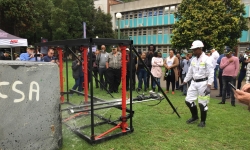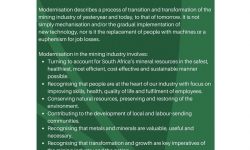Modernisation in mining – A people-centric approach
For the Mandela Mining Precinct, the journey to mine modernisation has as its end goal, to develop shared value for all people in the modernising minerals sector.
To this end, the Precinct has developed a research programme that focuses solely on the role of people in a modernised mine in South Africa.
For the Mandela Mining Precinct, the journey to mine modernisation has as its end goal, to develop shared value for all people in the modernising minerals sector.
To this end, the Precinct has developed a research programme that focuses solely on the role of people in a modernised mine in South Africa.
“As mining modernises, how are mining stakeholders affected and impacted by mining modernisation systems, processes and technologies? This is the key question framing our research agenda,” says Dr Sherin Ramparsad, programme manager responsible for the Successful Application of Technologies Centred Around People (SATCAP) research programme.
To date SATCAP has completed several literature reviews, which have delved into case studies and validated frameworks to understand how modernisation in mining can be effectively implemented, while at the same time taking into account all affected stakeholders.
Ramparsad believes that people are at the centre of all mining activities with drillers, winch operators and shaft timbermen being the heartbeat of mines. “Through our research, we need to look at what skills these mine employees will require in a modernised mine and this will allow us to make recommendations to the Mine Qualifications Authority on what those key skills are,” she said.
The SATCAP research programme comprises several research themes aimed at amongst others, understanding job losses through impact assessments; developing a community inclusivity model; and developing a process for the inclusion of mine employees in the design and development of equipment. The latter theme has already gained importance with the alignment of SATCAP to the Isidingo Drill Design Challenge under one of the other research programmes of the Precinct. This is further being addressed through a research theme led by the CSIR on people-centric modernisation. “We have found that the best practice approach to equipment design and development, was one that was people-centric,” says CSIR researcher Dr Jodi Pelders. She says the design should be suited to the individual using the equipment rather than people being put under strain to use a particular piece of equipment.
In the 2020-2021 period, the research team is planning to expand on the research undertaken to date to ascertain, amongst others, the perceptions held by various stakeholders in the industry – such as mining houses, organised labour and original equipment manufacturers– about the need for employee engagement during equipment development, as well as at what level this engagement should occur.
This is echoed by Nancy Coulson, senior lecturer at the Wits Mining Institute, who argues that the modernisation process has to be a bottom-up approach. “The issues are too complex, and it is important to understand experiences at the site level,-which will inform what is happening at a national level rather than the other way around,” she says. Coulson leads the research theme on stakeholder engagement and emphasises that there will be many stakeholders to engage in a mine modernisation context.
From the perspective of stakeholder engagement, Coulson discourages the adoption of digital technologies unless it comprises elements of two-way communication. The University of Pretoria (UP) Enterprises have been commissioned by the Precinct to develop a change management guideline for the mining industry. This research theme is led by Wessel Botha, senior consultant at UP Enterprises, who argues that the adoption of digital technologies in the change management process could be a viable option if the human element is strong. “The relationships of trust required to reduce employee resistance and obtain employee buy-in, necessitates the presence of a human element when digitising,” he says.
SATCAP research cuts across the other research programmes at the Mandela Mining Precinct and answers the difficult questions involving people facing change in the industry, whilst providing a platform for organised labour to gain an understanding of the change processes required for modernisation. To this end, research has centered around reviewing current change guidelines, and developing a new change management guideline; understanding the role of mine employees in equipment design; and designing frameworks to engage stakeholders. SATCAP research has received positive feedback from stakeholders across academia, industry and organised labour, which is reflective of the need to focus on people in the journey to mine modernisation.
The Mandela Mining Precinct is a public private partnership between the Department of Science and Innovation and the Minerals Council South Africa. The Precinct is co-hosted by the CSIR and Minerals Council.




